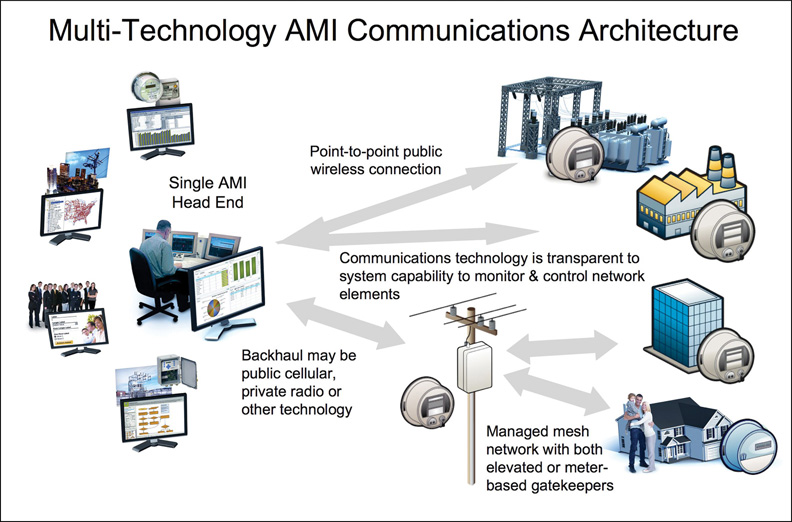Knowledge is power. It’s a lesson that the energy industry has taken to heart, as utilities around the globe build out new “Smart Grid” technologies to optimize antiquated grids. Smart grids hold the potential to transform the way electricity is generated, distributed, and consumed. With end-to-end intelligence about electricity transmission and demand, utilities will be able to reduce peak consumption by shifting demand loads, and boost efficiency through improved diagnostics – all of which will help to improve forecasting. Utilities have been quick to recognize this potential, and are rapidly making smart grids a reality. According to international market research firm, IDC Energy Insights, North American spending on intelligent grid technology will reach $17.5 billion by 20131. And, ABI Research – another noted research firm – projects that about 212 million smart meters will be deployed worldwide by 2014… up from 76 million in 20092.

Philippe Guillemette
Senior VP
Advanced Technology

Michael Longrie
Vice President
Product Management
Current smart grid investments span a broad range of technologies, but operators are focusing particularly on distribution systems. They are making investments that will modernize the power grid. One such area of investment is advanced metering infrastructure (AMI). AMI uses smart meters to help modernize the grid by providing the ability to remotely monitor and transfer energy consumption and power quality information more frequently and reliably, allowing utilities to work with their customers to manage the distribution network more efficiently.
By combining smart metering with home-area network (HAN) applications, consumers will soon be able to link “smart” thermostats, appliances and even electric vehicles with the metering infrastructure. Ultimately, they will be able to respond on a minute-by-minute basis to energy pricing changes, and remotely shift demand into off-peak periods when energy is more available and less expensive.
To make these benefits a reality, however, utilities need robust and flexible communication systems to meet the diverse network requirements throughout their service territory. It’s a given that communication is central to the basic concept of the smart grid, but there is no “one-size-fits-all” communication technology, and smart grid communications will ultimately encompass several. Options include private radio frequency (RF) mesh solutions that connect meters via a concentrator; point-to-point (under glass) communications with individual meters using public cellular networks (which also provide the backhaul for mesh networks); Power Line Communications (PLC); Wi-Fi; and several others.
In the past, utilities have most often considered AMI networks that offered a single (typically private) communications technology, referred to as a “single AMI technology solution.” In today’s market, however, utilities have other good options as well. Cellular networks have made significant progress in 2010, and can now offer lower airtime rates and tighter service-level agreements. In this environment, the best solution may be to recognize that there is no one “best” solution, and no need to choose between one metering communication technology and another. To unleash the full potential of the smart grid, utilities should be implementing metering communications platforms that encompass multiple communication technologies. These types of AMI solutions, referred to as “multi-technology AMI solutions,” can include both private radio and public cellular networks to suit a variety of environments and requirements, while still using a single AMI head-end. Let’s explore how modern cellular communications can fit into a multi-technology smart metering initiative, and the benefits that utilities can realize by implementing this multi-technology approach.
Achieving an Industrial- Grade Smart Metering Infrastructure
Utilities historically may have viewed cellular-based metering communications with skepticism, but the truth is that cellular technology is already widely deployed in the electricity grid. Many utilities rely on wireless technology to communicate with cellular-enabled meters at large commercial and industrial customers. In fact, the majority of utilities in North America today use public wireless networks (i.e., networks owned by carriers such as AT&T or Verizon Wireless) to backhaul metering information collected at the neighborhood-area network (NAN) level to a central location. Now, perceptions about using cellular technology all the way to the meter are beginning to change, as public carriers work closely with operators and vendors to introduce more attractive rate plans and demonstrate that they can meet the utilities’ stringent requirements.
Addressing Modern Metering Challenges
Any communication technology that will serve as the foundation for electricity metering must meet several core requirements, including:
• Life span. Smart meters are designed to stay online for 10, 15, or even 20 years, without requiring that components be replaced or directly maintained.
• Ruggedness. Meters – and all the technology within them – need to be highly reliable. Today, most common cellular technologies (such as the removable plastic Subscriber Identity Module, or SIM cards, used in some cellular networks) have been driven by the mobile phone market. Focused on general consumer use, these technologies are designed for a projected lifespan of just a few years. Smart metering communications, however, must be designed with industrial-grade specifications to meet extreme environmental conditions of shock, corrosion, temperature, vibration and humidity to which consumer devices are not typically exposed. Fortunately, industrial-grade cellular solutions are now a reality. For example, in extreme environments SIM cards can be embedded into the wireless module used in the meter or concentrator device to create a much more ruggedized design.
• Remote manageability. During the 10- to 20-year life span of a smart meter communication device, the communication module’s firmware will likely be upgraded—for example, to add new features, enhance security, or maintain compliance with the latest wireless communication standards. Having to make such changes manually, through a field service call for potentially millions of meters, would be an enormous burden. Utilities need to be able to remotely manage, configure, test, validate and upgrade firmware over the air using secure wireless device management services that the utility or service provider can easily deploy.
These are real and important considerations, and modern cellular technologies effectively address the issues. Ruggedized cellular solutions are now widely deployed in the automotive and industrial segments, where extreme temperatures, vibration, dust and humidity are the “norm.”
Applying these same types of specifications to smart meters, vendors are now achieving industrial-grade reliability and life spans. Public wireless coverage is also now more than sufficient to support multiple smart metering applications, with approximately 97 percent of North America’s population, for example, covered by cellular networks today.
Modern cellular solutions are also designed to be flexible and upgradeable. For example, today’s state-of-the-art wireless modules can perform firmware upgrades as patches. That means wireless providers can distribute upgrades by transmitting only those parts of the firmware that have been changed (i.e., a software package of a few kilobytes), rather than transmitting a new version of the entire software stack (one megabyte or more). When utilities are paying airtime rates for millions of end devices, patch upgrade capability equates to a significant bandwidth and cost savings.
Addressing Security
When there is a two-way command and control system embedded into an energy management system, several security threats need to be addressed, including consumer privacy, data integrity and maintaining continuity of service throughout the grid. Fortunately, utilities don’t have to reinvent the wheel to enable secure wireless communications. Wireless and cellular infrastructures already include strong and proven security technologies (technologies capable of supporting critical public safety and government applications), in addition to the security measures provided by multi-technology AMI vendors.
For example, the U.S. armed forces, the Central Intelligence Agency, and President Obama use highly sophisticated Federal Information Processing Standard (FIPS) 140-2 software in their wireless smart phones. As a more mundane but ubiquitous example, people use robust, readily available and cost-effective encryption technologies millions of times each day to protect retail and financial transactions over wireless networks.
Modern cellular solutions provide:
• Secure connectivity. In any communication system, it is essential to ensure that sensitive information reaches its intended recipient, and that it cannot be intercepted or understood by an individual or device attempting to intercept it. This is especially true when the information is contractual data used for billing purposes. Strong authentication processes are also mandatory to prevent hackers from accessing sensitive data, uploading malicious software, or turning meters on and off. Modern wireless communication systems employ strong and mature encryption protocols such as Secure Sockets Layer (SSL), which is already widely used to protect retail and web-based payment card transactions.
• Jamming detection. In some higher risk environments, defensive systems are needed to thwart deliberate network attacks, such as denial-of-service attacks that attempt to jam all frequencies to block the wireless connection. Modern smart meters can be equipped with wireless technologies that quickly detect such attacks and take appropriate actions, such as triggering an alarm, sending an alert through another communications channel, recording the event for further investigation, etc.
• Ability to operate autonomously. Another important requirement for secure smart metering communications is the ability to continue metering even in the event of a breach of communications. Today’s industrial-grade, cellular-enabled smart meters are intelligent devices that are capable of continuing to operate even if they lose connectivity with the wireless communications network.
Clearly, modern wireless security technologies are up to the task. The challenge is to adopt an industry-wide standard that will ensure interoperability within the vendor community. Standards-making bodies such as the National Institute of Standards and Technology (NIST) are in the process of developing standards, but no agreed-upon standard is approved at this point. The process is complicated by the broad variety of metering communications technologies in the market today, including multiple proprietary and open technology platforms.
Naturally, utilities are concerned about how this standards process unfolds, as they want to be able to ensure they are ultimately in compliance. The key once again is to make sure that any smart metering communications technology is flexible and upgradeable.
Reaping the Benefits of Multi-Technology AMI Deployments
As we’ve seen, public cellular communications are ready to meet the demands of modern smart metering deployments. But what do utilities gain by employing them? As many utilities are now discovering, incorporating cellular communications as part of a multi-technology smart metering architecture unlocks a variety of advantages. These include:
• Flexibility. A smart metering infrastructure that supports multiple technologies can be more easily extended across a variety of regions and environments, out to the edge of the network. For example, a utility could serve some neighborhoods on the network using RF mesh, while serving others through a cellular carrier’s wireless network.
• Improved visibility. One challenge utilities have faced in the past when incorporating multiple communication technologies within an AMI network was the perceived headache of managing and integrating multiple technologies, because each technology would require a separate head-end. However, in today’s multi-technology AMI networks, a single head-end can manage multiple technologies. Additionally, modern cellular modems used in a meter can now provide valuable information to the AMI head-end about the operation of the cellular network, just as is done with the private radio network.
• Distribution automation. In the past, utilities have had little visibility into major segments of the distribution system, particularly transformers within neighborhoods. While utilities have long recognized that the ability to collect information from those devices would be valuable, the cost of creating an infrastructure specifically to support that communication would have been exorbitant. Now, with communications extending to the meter over a variety of communication technologies, utilities can piggyback on those communication infrastructures to connect previously inaccessible devices and distribution points. Cellular modems in meters can effectively communicate with these devices, and as with the multi-technology AMI deployment itself, utilities can choose the communication technology that is most effective for each situation. As a result, utilities are now empowered to monitor and automate distribution all the way to the consumer home, for little additional expense on top of the existing smart metering investment.
• Cost savings. Using multiple technologies allows operators to choose the least-expensive solution for each environment across a region. For example, while cellular metering communications may not have made good economic sense in the past, cellular carriers are now actively courting utilities and will work with them to aggregate services under one rate structure. Utilities can also realize savings by consolidating their mobile workforce, supervisory control and data acquisition (SCADA), and enterprise accounts. In some cases, carriers will also offer utilities service-level agreements, when accompanied by managed machine-to-machine service platforms that give the carrier and the utility more visibility into and control over their wireless devices.
Ultimately, a broad number of business scenarios are emerging in which the multi-technology approach provides the most options for extending smart metering intelligence across the grid, and realizing the most value from smart grid deployments.

AMI solutions architected for multi-technology communications offer the utility cost efficiency and future flexibility.
A Versatile Foundation for Smart Grid Communications
Choosing the right communications solution for a smart metering initiative is critical, but just as critical is recognizing that there may be no single “right” answer. The best solution may, in fact, be to build an architecture that is capable of supporting multiple technologies.
Public wireless communications will play an increasingly important role in smart grid implementations, and utilities should be evaluating those areas where cellular technologies can provide real value to the overall smart metering initiative.
To succeed in this, however, utilities need to ensure that smart metering solutions (whether employing cellular or any other technology) are rugged, secure, flexible, and remotely manageable and upgradeable.
Utilities should also make sure they are working with technology partners that are:
• Well established with strong financials (i.e., able to continually support smart metering technologies throughout the 20-year or longer lifespan of the metering devices)
• Broad-based, with the ability to accommodate a variety of wireless technologies and platforms, and service all regions
• Experienced, with broad expertise in smart metering devices and communications, and established relationships with public wireless operators
• Proven, with a track record of delivering reliable, industrial-grade communication technology
By following this strategy, utilities will deploy far more flexible and cost-effective smart metering infrastructures, and more rapidly reap the rewards of their smart grid implementations.
About the Authors
Philippe Guillemette is Senior Vice President of Advanced Technology at Sierra Wireless, where he is responsible for driving advanced technology initiatives and long-range product and solution strategy. Prior to joining Sierra Wireless in March 2009, Philippe served as Chief Technology Officer and later, Vice President of Marketing, for Wavecom. Philippe joined Wavecom in 1993 and held various positions there, including Vice President of Research and Development, Vice President of Technology, and Director of Software Development. Prior to joining Wavecom, Mr. Guillemette was a software engineer at Nortel Networks.
Michael Longrie is Vice President of Product Management at Elster Solutions, where he directs the EnergyAxis Product Management team. Michael brings both vision and experience to his leadership role in Product Management, guiding the development of strategic solution roadmaps as well as ensuring the successful release of near-term product and solution deliverables. He holds a BS in Electrical Engineering, an MA in Economics from the University of Colorado and an MBA from the American Graduate School of International Management.
1 Torchia, M., Feblowitz, J., Nicholson, R., North American Intelligent Grid Utility Spending Forecast. (Dec. 2009). IDC Energy Insights
2 Smart Meters for Smart Grids. (Jan. 2010). ABI Research.







